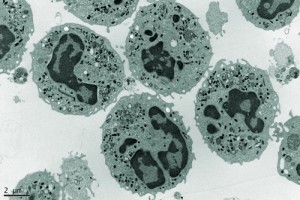 A new study, entitled “Activation of the pseudokinase MLKL unleashes the four-helix bundle domain to induce membrane localization and necroptotic cell death” published in the journal Proceedings of the National Academy of Sciences by Dr Joanne Hildebrand, part of Professor John Silke’s research group from Cell Signaling and Cell Death division at The Walter and Eliza Hall Institute of Medical Research in Australia, has identified a small molecule that inhibits necroptosis, a form of cell death, that induces inflammation. The new discovery may pave the way for potential new therapies for inflammatory diseases such as rheumatoid arthritis, Crohn’s disease and psoriasis.
A new study, entitled “Activation of the pseudokinase MLKL unleashes the four-helix bundle domain to induce membrane localization and necroptotic cell death” published in the journal Proceedings of the National Academy of Sciences by Dr Joanne Hildebrand, part of Professor John Silke’s research group from Cell Signaling and Cell Death division at The Walter and Eliza Hall Institute of Medical Research in Australia, has identified a small molecule that inhibits necroptosis, a form of cell death, that induces inflammation. The new discovery may pave the way for potential new therapies for inflammatory diseases such as rheumatoid arthritis, Crohn’s disease and psoriasis.
Necroptosis is considered to be complementary to the classical caspase-dependent programmed cell death pathway, while apoptosis is a recently discovered cell death pathway linked to immune disorders. It is a vital process in which cells undergo programmed death while warning the immune system that something has gone wrong, such as during viral infection. But when necroptosis is improperly activated, it can induce inflammation and the development of inflammatory diseases.
Dr. Joanne Hildebrand, Ms. Maria Tanzer, and collaborators were elucidating the mechanism of killing by the protein pseudokinase Mixed Lineage Kinase Domain-Like (MLKL) through the process necroptosis. They found that a particular portion of MLKL “opens” when the protein is activated enabling the binding to the cell membrane and induce cell death. Dr Hildebrand said that, “It’s like flicking a molecular switch. We showed that when the switch can’t be ‘turned on’, MLKL doesn’t become active and necroptosis is prevented. MLKL is the final protein in the cell death pathway but it needs to be activated before it can kill the cell,” said Dr Hildebrand in Walter Eliza Hall press release. “Understanding how it becomes active can help uncover new ways to treat disease.”
In collaboration with Dr. Isabelle Lucet, Associate Professor Guillaume Lessene and colleagues from the ACRF Chemical Biology division, the research team tested a range of small molecules to inhibit the activation of MLKL and identified a small molecule that binds the nucleotide binding site inside the MLKL pseudokinase domain and slows MLKL translocation to membranes, thus preventing necroptosis. “This small molecule binds to MLKL in such a way that it ‘jams the switch’ that makes it active,” said Ms. Tanzer. “We are really excited by this discovery because not only have we shown this particular part of the protein is essential for necroptosis, we also have a starting point in a drug discovery program.”
The team of researchers will start a collaborative project with Catalyst Therapeutics to develop an effective novel drug based on the small molecule identified in this study. “MLKL is an appealing target because research suggests it does only one thing, which is killing the cell,” said Dr. Murphy. “Blocking this protein doesn’t impact other functions of the cell, reducing the chance of unwanted side-effects.” added Dr Murphy. “If we can create a compound that better targets this particular part of MLKL, we can prevent necroptosis and improve treatments for inflammatory disease.” concluded Dr Murphy.
This research was financially supported by the Australian National Health and Medical Research Council, the University of Melbourne, the Australian Research Council, the Australian Cancer Research Foundation and the Victorian Government, as reported in Walter Eliza Hall press release.

